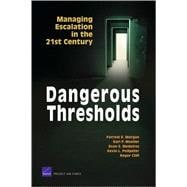
| Preface | p. iii |
| Figures | p. ix |
| Summary | p. xi |
| Acknowledgments | p. xxiii |
| Glossary | p. xxv |
| Introduction | p. 1 |
| Background | p. 1 |
| Contemporary Challenges | p. 3 |
| Purpose of This Monograph | p. 4 |
| Organization and Approach | p. 5 |
| The Nature of Escalation | p. 7 |
| Understanding Escalation | p. 8 |
| Thresholds and the Subjectivity of Escalation | p. 11 |
| Limited War | p. 14 |
| Escalation Dominance | p. 14 |
| Dimensions of Escalation: Vertical, Horizontal, and Political | p. 18 |
| Escalation Mechanisms | p. 19 |
| Deliberate Escalation | p. 20 |
| Inadvertent Escalation | p. 23 |
| Accidental Escalation | p. 26 |
| Complexity in Escalation | p. 28 |
| Motives for Escalation | p. 29 |
| Instrumental Escalation | p. 30 |
| Suggestive Escalation | p. 31 |
| Other Motives for Escalation | p. 33 |
| Dynamics of Escalation | p. 34 |
| Constraints on Escalation | p. 36 |
| Escalation and Instability in the 21st Century | p. 38 |
| New Escalation Options | p. 38 |
| Perceived Political Fragility | p. 40 |
| Windows of Opportunity and Vulnerability | p. 40 |
| Indifference to Escalation Risks | p. 42 |
| Anticipating and Managing Escalation | p. 43 |
| China's Thinking on Escalation: Evidence from Chinese Military Writings | p. 47 |
| Introduction | p. 47 |
| Background and Conceptual Issues | p. 50 |
| Understanding Chinese Views on Escalation and War Control | p. 51 |
| The Conceptual Foundation of War Control | p. 52 |
| Operationalizing War Control: Military Measures to Contain Warfare | p. 54 |
| Assessing Chinese Escalation Behavior Through the Lens of the Second Artillery Doctrine | p. 58 |
| Second Artillery Nuclear Operations and Escalation | p. 61 |
| Key Nuclear Doctrine Concepts | p. 63 |
| Additional Questions About Second Artillery Nuclear Operations | p. 65 |
| Second Artillery Conventional Missile Strike Campaigns | p. 68 |
| Implications for Chinese Escalation Behavior | p. 70 |
| Chinese Views on Space Warfare and Escalation | p. 71 |
| Conclusion | p. 76 |
| Regional Nuclear Powers | p. 83 |
| Escalation Risks Inherent in Emergent Nuclear Capability | p. 85 |
| Sources of Regional Instability | p. 88 |
| Instability and Risks of Escalation in Northeast Asia | p. 89 |
| Instability and Escalation in South and Southwest Asia | p. 95 |
| Risks of Escalation in the Ongoing Conflict Between India and Pakistan | p. 97 |
| Risks of Escalation Due to Domestic Instability in Pakistan | p. 106 |
| The Risks of Escalation in a Conflict with Iran | p. 109 |
| Conclusion | p. 113 |
| Escalation in Irregular Warfare | p. 117 |
| Irregular Warfare's Many Paths of Escalation | p. 118 |
| Escalation in Stability Operations: Two Illustrative Cases | p. 124 |
| Multiple Actors in a Complex Strategic Environment | p. 126 |
| Multiple Conflicts Exist Simultaneously | p. 127 |
| ROE and the Challenge of Complexity | p. 129 |
| Dramatic Asymmetries of Power, Interest, and Commitment | p. 131 |
| Irregular Warfare Undermines Traditional Escalation-Management Approaches | p. 132 |
| Escalation in the Global Jihad | p. 133 |
| The Roots of Global Jihad | p. 134 |
| The Escalation Dynamics of Global Jihad | p. 135 |
| Escalation in Response to Global Jihad | p. 141 |
| Escalation Management in the Struggle Against Global Jihad | p. 150 |
| Strategies in the Global Jihad | p. 153 |
| Managing the Escalatory Effects of Global Jihad | p. 154 |
| Conclusion | p. 157 |
| Managing Escalation in a Complex World | p. 159 |
| The First Step in Managing Escalation Is Understanding Its Nature | p. 160 |
| Deterring Deliberate Escalation | p. 160 |
| Managing Inadvertent Escalation: A Matter of Clarifying Thresholds | p. 163 |
| Managing Forces to Avoid Accidental Escalation | p. 165 |
| Dominance as a Means of Escalation Management | p. 165 |
| The Role of Technology in Escalation and Escalation Management | p. 168 |
| Managing Escalation Risks in Today's World | p. 169 |
| Escalation Management in a Limited Conflict with China | p. 169 |
| Managing Escalation in Confrontations with Other Regional Nuclear Powers | p. 170 |
| Escalation Management in Irregular Warfare | p. 172 |
| Recommendations for the U.S. Air Force | p. 174 |
| Appendixes | |
| China, Force, and Escalation: Continuities Between Historical Behavior and Contemporary Writings | p. 177 |
| Case Studies of Escalation in Stability Operations | p. 197 |
| Modified Method for Delphi Analyses | p. 221 |
| Bibliography | p. 225 |
| Table of Contents provided by Ingram. All Rights Reserved. |
The New copy of this book will include any supplemental materials advertised. Please check the title of the book to determine if it should include any access cards, study guides, lab manuals, CDs, etc.
The Used, Rental and eBook copies of this book are not guaranteed to include any supplemental materials. Typically, only the book itself is included. This is true even if the title states it includes any access cards, study guides, lab manuals, CDs, etc.